Here’s the other side of the coin from my alcohol-laced Cutlass post. And timely, as I just spotted this today over coffee on Finding Future Classic Cars.
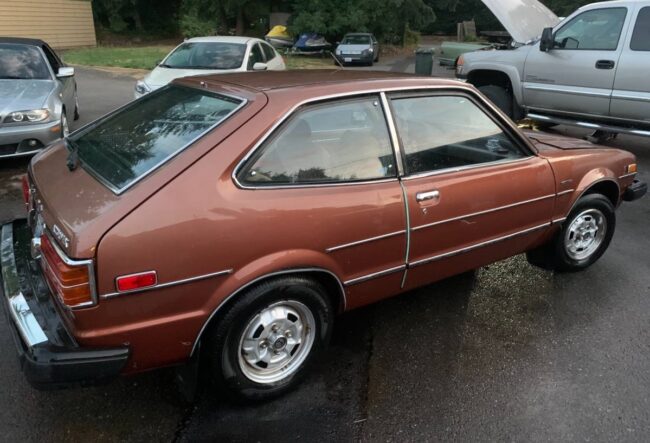
The first one. First of a crapload of Honda Accords. Yup. Initially available as a two door liftback only, perhaps a surprise to our younger readers who associate these as midsize suburban sedans seen, well everywhere.
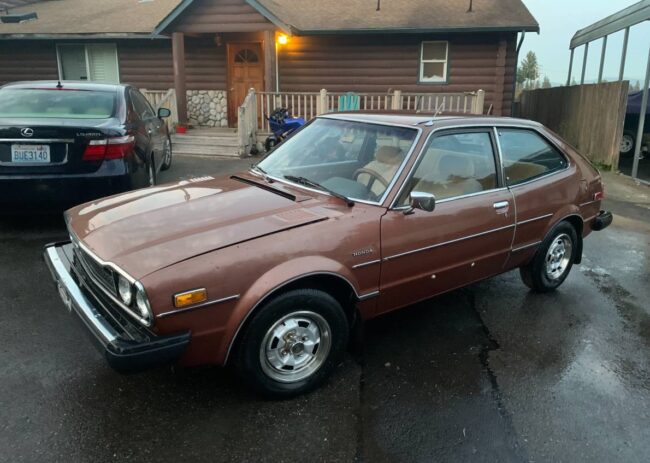
Of course a sedan came along quickly, my friend Chris Green has a mint ruby red one with red velour, but the two door was the sole choice that first year, 1976. And now you can get this nice one in Seattle for four grand if you’re so inclined. In that oh so ’70s combo of root beer brown with tan velour!
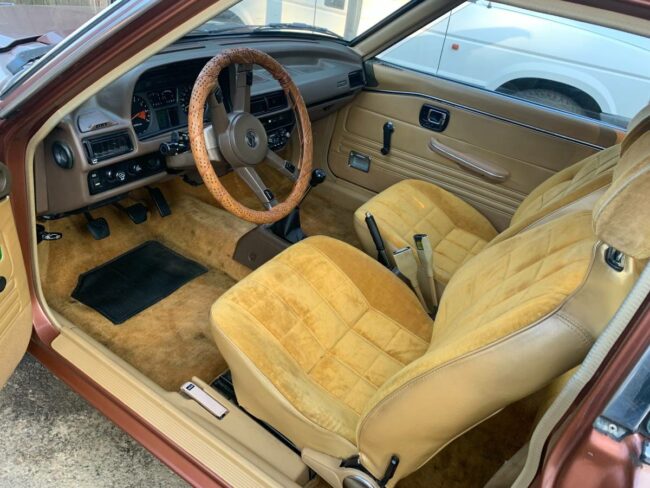
Ad is short and sweet: “79 Accord 5speed, 150k. Runs Good, fresh Head With Weber carb (Have Original Carb and Air Cleaner), interior is Almost Mint.”
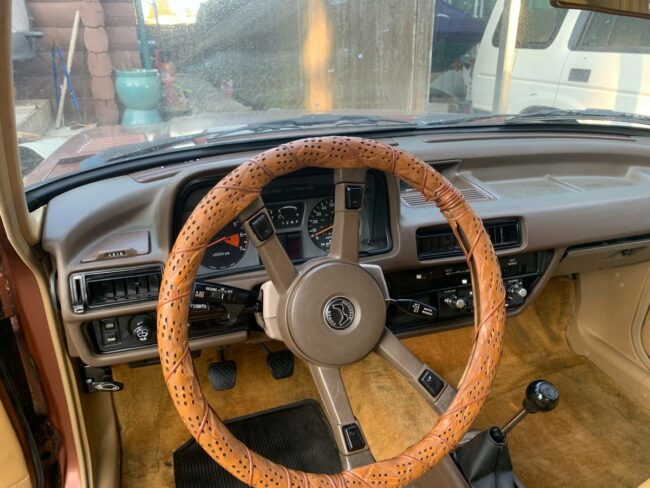
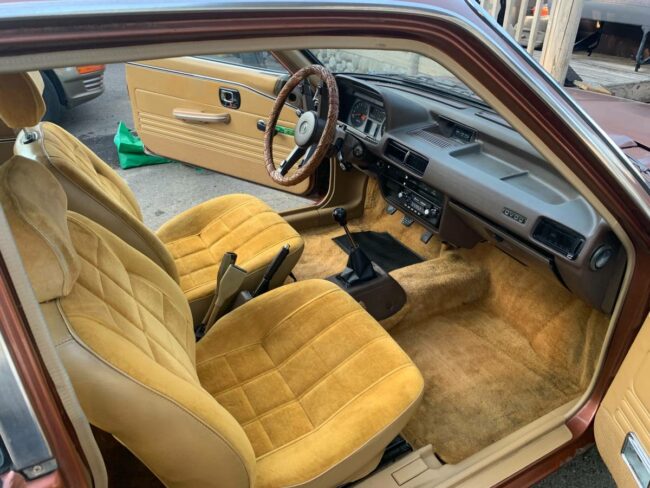
“Body Straight and Rust Free. The Car is 42yrs Old and in Really Good Condition. $4,000 OBO.” Neat little time capsule. I haven’t seen one since maybe 1991-they dissolved rapidly in the Midwest. I don’t remember anyone having one when I was a kid, but neighbors across the street had a nonmetallic brown Civic of this vintage circa 1988.
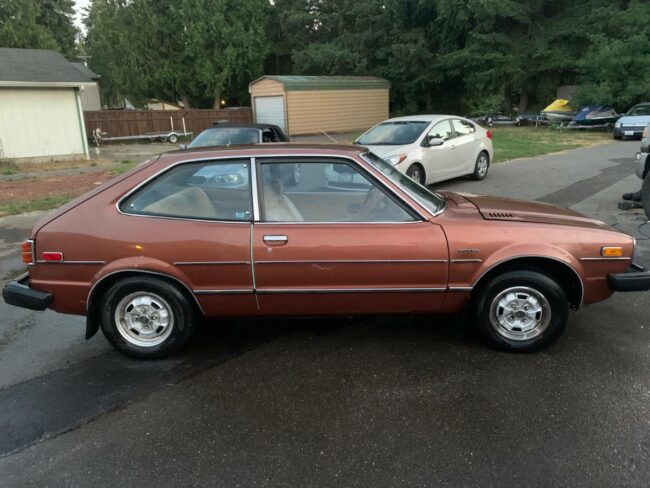
No, wait. Actually, I seem to recall the Rock Island Honda dealer having a mint one in the showroom circa 2011-12. They were still downtown then, believe it or not. But shortly thereafter, they moved to a brand spanking new, gigantic facility in Moline. I believe they had an equally nice ’75 Civic too.
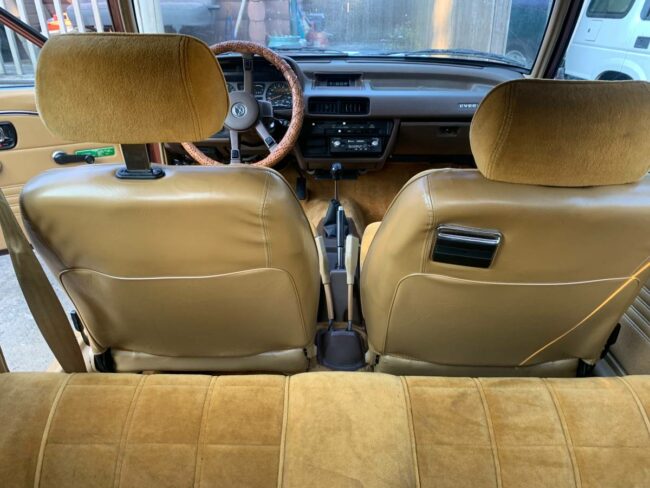
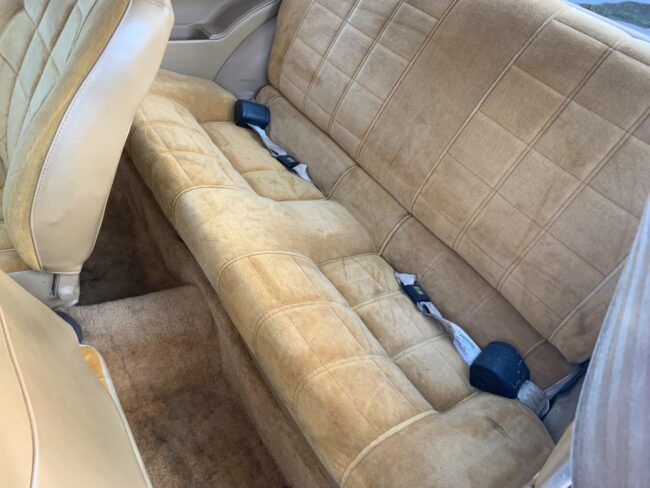
So all you fine folks talking the talk recently, here you go: Buy it. Good luck finding that missing side molding though, ha ha.

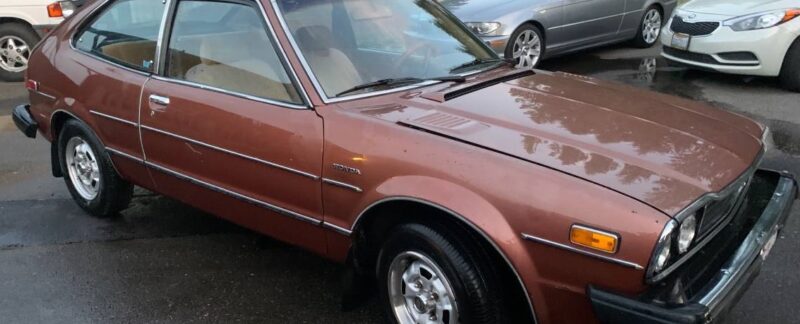

My uncle had one of these, silver with black interior. My Dad taught me to drive stick shift in it. You’re oh so right, Tom–these things were everywhere in the late 70s.
Those are amazing bumpers.
Yes, back in the day when bumpers were for bumping, not just additional pieces of body work that willl cost you $1000 to replace if you or someone else misjudges by an inch or so.
I hate modern bumpers.
My new bride bought a light blue ’77, only waited 3 months to get to the dealership. It was fabulous for the time, well screwed together, a list of standard features that made everyone else envious, etc. Alas, the 76-77s had a minor flaw, they blew head gaskets like clockwork. Had 3 by 45,000 miles. Honda/dealership just fixed them no questions asked. So this is a good year, albeit not surprising he still had to replace the head. If you compared the workmanship of that Honda to my dad’s new ’79 LeSabre you can begin to understand why VFW parking lots went from all domestic in the early 80s to a sea of Hondas and Toyotas by the mid 90s (and isn’t because all the WWII vets went away).
Is this the car Bruce Willis drove in Pulp Fiction?
No, that was an ’80-’81 Civic. Pam Grier had an identical one in Jackie Brown, too (also replaced by a dead guy’s much nicer ride). Supposedly it’s what Tarantino drove in his early days.
I wonder if the non-factory side molding and wheel arch trim were profit enhancing dealer add-ons in 1976. Given the fine condition, it must have also had the added protection of dealer installed Tru-Coat.
“OK. I got them to knock $100 off the Trucoat.” 🙂
Who would have thought that the Sunbird would have the higher asking despite this one having just had the engine apart. The Sunbird Tom found did have better trim but I do like the back seat ashtray of the Accord and not doubt the small tunnel will drive wild the teenage boy Consumer Reports reader. They I think were both in Seattle, maybe Hagerty could do a comparison test.
“I haven’t seen one since maybe 1991-they dissolved rapidly in the Midwest. I don’t remember anyone having one when I was a kid, but neighbors across the street had a nonmetallic brown Civic of this vintage circa 1988.”
These did rust hilariously fast in the Midwest and were all but gone by the early ’90s. The cloth upholstery also quickly disintegrated if you so much as uttered the word “sunlight” around it. Same with Datsuns, most rear-drive Toyotas, etc. It was very rare for a Japanese car made before about 1985 to last more than 10 years here.
But don’t kid yourself, the domestic stuff didn’t last either.
Chevy sold more Citations in ’80 alone than Honda produced across the Accord’s entire ’76-’81 first generation run, but damned if they weren’t also rarer than hen’s teeth after a decade. Same goes for the Monza, the Pinto, Colonnades, any ’70s Chrysler, etc. Chicagoland was hard on everything. Stuff like the post-’77 GM B-bodies and Panther Fords seemed to last longer, but that might have had as much to do with owner demographics and interminable production runs as much as inherent durability; Even so, pretty much every example of a B-body I personally encountered was a clunker by the 6-7 year mark. Early FWD A-cars, despite that platform’s later reputation, were pretty fragile and were off the road pretty quickly. So was the early Tempo/Topaz.
Oddly enough, one car that stands out as being particularly roach-like is the ’77-’79 T-Bird despite its donor platform being one of the biggest rust buckets Ford ever made.
The rust was a problem.
In those years I lived in a small resort town in New York State, working for the village DPW. Japanese cars were catching on, and fast. Our foreman, who had made a living operating equipment such as OshKosh snowplows and backhoes, owned a Toyota pickup. Our Administrator, a fix-it troubleshooter…half office and half field…bought one just like it. Our plumbing and HVAC guy, traded in his Pinto for a Civic four-door hatch when they came out.
See a pattern? Nobody wanted what Detroit was selling; because what they were selling was overpriced land-barges that got eight miles a gallon. American subcompacts were judged inferior, and were.
Of course all of these buyers got it in the neck with the rust – which wasn’t really a surprise in an area where they got 280 inches of snow every winter and practically paved the roads with rock salt. The VW Beetles and Type 4s that other employees (myself included) owned, also rusted fast enough you could almost hear it.
But. The times were changing. Japan saw; Japan took notice; they learned, and quickly. Honda took the step of buying back many of their early rust-buckets. Toyota has done amazing work in controlling body corrosion. Whereas, Detroit, as with everything that improves an automobile…they just hoped it would go away, and then made half-hearted approaches. Serious corrections are quite recent.
Unfortunately, the rustproofing didn’t come in time to enhance these light, flickable, economical, dynamic, forward-thinking cars. Especially not the Accord, which is a winner in just about every other category. I’d love this Seattle example; it’s not that far from me, 400 miles, and I could raise the scratch. But I’d be wondering and waiting, how long before this survivor goes the way of all its siblings.
Today’s CAFE-ized, NHTSA-ized cars, including the Asian offerings…are just dead to drive. Numb electric power steering. Engines with low redlines and ten-speed automatics. Power brakes that might as well be electric actuator buttons on the floor – ABS, power, no error, no thought. Perfect for the Millennials.
Not so perfect for someone who had owned a 1972 Super Beetle, had test-driven an Accord, but couldn’t make the finances work. So all that’s left are memories.
To our import loving friends. I will just ask the question and not comment further bit I am interested in the answer. Why was the Accord the answer to your period needs? It is sometimes called the Japanese Sirocco. There was however a German Sirocco. It was faster, better looking, lighter, better handling, at least equally trimmed, with a bigger dealer network. It was quite short geared, but that would seem to bother domestic buyers more than imports. I know the price was a grand higher but VW dealers just required a little buyer initiated dickering rather than the Honda just bend over and take it hard and deep approach. You guys were younger and higher percentage female, did that aspect actually appeal? Why was VW not rushing to get crazy high Sirocco volume into Westmoreland?
@John C. this was popular with a different buyer than the sirocco. they weren’t looking for performance. in fact, most of them went out the door with the pretty crappy honda-matic. these were for mom’s that didn’t want a station wagon. they were then handed down to the teenage kids in their senior year of high school. they were sporty but not sports cars. they were cheap and you could get them serviced just as easily and cheaply as the domestics where i grew up. vw rabbits were popular, too but they were kind of spartan compared to the hondas.
If you’d owned a Volkswagen in that era, John, you’d know why.
My ex bought a Fox (Gol) in 1987. Her father bought a 1982 Sciracco the same year.
BOTH were pieces of schitte. Troublesome and expensive to repair and maintain.
Which revealed the differences between German and Japanese consumer-market philosophy. Both respected engineering…but the Germans, blessed with the ethics of grave-robbers, viewed the customer as a MARK.
The Japanese understood, or were taught to understand, that a sale is not an end – it’s the beginning, the start of an ongoing relationship that, done right, can last a lifetime. The Japanese companies fell short in many areas; and in many of those misses, they did the best they could to make things right. With early Camrys, there was an issue with starter/flywheel alignment. My mother’s example, went out at 35,000 miles. About the same mileage as Olds diesels started failing.
Toyota repaired it with a hidden warranty; and what’s more, they instructed their dealers to HELP owners get the repair. The multiline dealer, Spitzer (notorious for ripoffs with other brands they carried) willingly towed the car at their expense out of her garage, and pulled the engine, replaced the starter and pressed on a new ring gear. Cost was NOTHING.
And it made my mother a customer for life – she bought two more Toyotas in her lifetime.
Neither I, nor my ex, nor her father nor her brothers nor any friends or family of hers, will ever again own a VW.
Which is the smarter, more-equitable, fairer approach? Why should a customer NOT reward this sort of marketing?
@ J.P.T. :
As a VW & Mercedes owner lover and Mechanic I wish I could argue your point….
-Nate
“Because of their eyes. They don’t look like use. That’s why.”
Sarcasm off.
There’s a consistency that he has. Asians bad, Euros good. No nuance, no difference. He has the biggest hard on for South Koreans.
If I get burned, there’s so many choices out there I don’t need to say “Thank you sir, may I have another”.
If I get treated well, why not let it ride, until I get burned. 40 years later, I’m still waiting to get burned.
If you are waiting for perfection, you will wait forever. Nothing is 100%. You try to pick the best for you at the moment you need to pick.
The VW dealers near me were dicks. That’s why.
I owned one.
The Honda dealers were a take it or leave it, markup or sticker. But, once you bought it, they treated you right. At least they did me. VW never did. My 81 4 door Accord lasted 136K. Was never the same after the accident I had. My fault. Had it fixed at a Ford collision shop. The repair guys were impressed.
Of course my next car was another Accord. 263,000 miles.
Then the one after 236,000 miles.
Now I have a CRV and only about 90,000 miles on it. I don’t drive like I used to.
I just love brands like this that are dogs.
Like a moth to a flame.
I know the price was a grand higher
That’s $4,770 in 2021 dollars. It would have taken some real dickering to make up the difference. Also, with the exception of the original air-cooled models, VWs have never been particularly inexpensive to maintain and repair.
Why do you have such a hard time believing that the Accord was a good car, a landmark even? There are reasons why there are a couple of Accords in the Henry Ford Museum’s car & truck display.
As I’ve mentioned, my brother bought one of the first ’76 Accords, with a stick and the trim package that included A/C and a stereo. He bought it because he’d owned a Mini Cooper and wanted a modern FWD car. Having owned a Honda motorcycle, he trusted the brand.
The first Accords weren’t perfect, no car is, but their primary flaw was the same as all Japanese cars of the era, they rusted badly on salted American roads. Otherwise, they were great cars. Admittedly, I’ve never driven one with an automatic but then only the domestics made good automatics until the 1980s.
By ’84, when my father bought an Accord hatchback that I more or less inherited when he died five years later, Honda had pretty much addressed the rust issue. As an adult, I’ve bought just three new cars, a ’91 Dodge AWD minivan, a 2000 Ford Explorer, and my current Honda Fit (well, four cars as I totaled my first Fit a few months into ownership). The ’84 Accord was a superb car. My Fit has a few minor issues, but absolutely nothing was wrong with my dad’s Accord.
Thanks to everyone that left their thoughts to my question, well Degal got a little rough but there is nothing wrong for him to stand up for his own, gosh knows I reserve that right. You all agree that the Accord made a sensation in 1976 and that is true. When the Mustang made a sensation it sold 400,000 in the first year. The Accord sold 18,000, even the non sensational 76 Sunbird managed 4 times that. We were getting into that modern period where some opinions mattered more than a mass of others, like notoriously when Nixon was reelected in a landslide and the New York Times film critic Pauline Kael only knew one person that voted for him. Her guy won the next time and over time there were a lot more Accords than Sunbirds or Siroccos
The Accord didn’t go on sale until June of ’76 and volume increased tenfold by 1980. Pretty much the opposite trajectory of every domestic small car built in this era. But you go ahead and keep grasping at straws to protect your narrative.
“We were getting into that modern period where some opinions mattered more than a mass of others, like notoriously when Nixon was reelected in a landslide and the New York Times film critic Pauline Kael only knew one person that voted for him.”
Ironic. You’ve been a broken record on this site (and others) for years about how anything not made by “proper” white people is objectionable crap. Your ad hominem rantings make up at least a third of the comments on any given old car post. Yet you think you’re some sort of martyr whose opinion is undervalued.
You and Ms. Kael strike me as having a lot in common. Both your heads are lodged in the same place, for one.
I knew plenty of people with early small Accords before they morphed into Impalas from Ohio. I never heard a one of them object, proving it was not the car itself that mattered but the name on it. Contrast today with Ford Mustang people, fans of the actual car, asking WTF to the name and styling details showing up on that electric CUV. Just named EV of the year! by C/D by the way. So again no defense from gonzo and now female industry press. When the culling of so many sedans happened in 2020, C/D listed them and asked rhetorically will we miss any of them. True to gonzo female form they acknowledged the Civic coupe.
I believe the 1st- and 2nd-gen Accords to be the most overrated cars in automotive history. I say this having dated a girl with an ’81 Accord (1st-gen) and married a girl with an ’83 Accord (2nd-gen). People look back through rose-colored glasses and remember the excellent fit and finish when these Accords were new, but seem to forget how quickly they rusted to the ground and how poorly they ran after one of the myriad rubber vacuum hoses aged enough to crack, and no repair shop could seem to fix them.
The fuel-injected Hondas that appeared in the mid-80s were a different story (LX-i, Si, etc). No more driveability issues. And twenty years later, Honda figured out how to make cars that can withstand road salt. My Odyssey is amazingly rust-free after 13 Ohio winters.
But to this day, I would never own a carbureted Honda with more than two wheels.
A good looking survivor .
These rusted in Los Angeles too for what that’s worth .
No way you’d get it past the smog testing in California with that Weber carby .
-Nate
growing up in nj, these hondas were everywhere. most familys had at least one two door car. before the accord there was usually a chevy nova, oldsmobile cutlass, ford granada, etc. the honda was a direct replacement and and they were nicer. bucket seats, floor shifters, good stereos. the dealers treated their customers better than the domestic dealers and the hondas were beautifully prepped and had very few problems compared to the big three. they were easy tho drive and the compact size and lift back made grocery getting a breeze. all of our parents had been ripped off by the deadly sin domestics and were happy to dump them for these cheap fun and practical imports. most never looked back.
Good summary. These were sold as second cars for round town use and commuting, and the initial build quality rivaled what you got from MB. Even the base models had lots of standard features that the Big 3 and VW charged extra for if they offered it at all (i.e. rear window defroster, reclining bucket seats, 5 speed manual) so you didn’t feel like you were in a penalty box as you did with all the domestic small cars and base versions of VWs. They were also fun to drive, especially with the slick shifting manual that a lot of them were sold with, and the rev happy motor was smoother and had less hesitation and stalling than most rivals at least until the vacuum hoses rotted out. Sure they rusted out fast in salty places, and you might need a head gasket by 50K, but most of the competitors had similar problems and had far fewer positive attributes.
One small thing I noticed about the burgundy 1980 Accord 4-door that we bought used in 1982: The silver paint on the wheels looked almost jewel-like, and I don’t remember ever seeing one of those wheels with rust on it. VW Bugs also had silver wheels; I saw those still on the dealer’s lot with rust on them.
I’m from Northeast Ohio, the lands of ice and snow… I dated a young lady who had been “gifted” her parents 1977 or 1978 Honda Accord when they got something else to drive (Hell, this is 40+ years ago, cut me some slack). The car was pretty well equipped, but I have no idea what gymnastics were necessary to acquire the car. By the time she had the car, it had already gone through it’s first set of front fenders (friends with Volares and Aspens knew how that felt) and the other rust and vacuum leaks were starting to take their toll. The car’s interior was already starting to sag, too. The thing was a gutless wonder with the Hondamatic and when you turned on the air, it was even slower. I can remember her father talking about how well the dealer treated them when the car had problems (which was fairly often, apparently), about how they always had a free loaner car and other things. I thought well, that’s great, but I’d rather not have to have my car in the shop in the first place.
If you had one of these back in the day and loved it, more power to you. My first interactions with early Civics and Accords never impressed me much. Give me a slant six Valiant four door if I have to ride in a penalty box, at least I’ll have the Hamtramck hummingbird (the starter motor) to keep me company.
I had a ’68 Plymouth Valiant that I bought for $50 when it had almost 100,000 miles. I loved that car but have to say the early Accords were better. We were living in Ann Arbor and there was an auto parts shop in Canton, about 20 miles away, that sold (allegedly) rebuilt starters for $19.95. Having replaced more than one starter on a VW Bus, which seem to require having a joint in my forearm midway between my elbow and wrist, and blindly getting nuts started on bolts as the starter was located behind the engine’s cooling shroud, I appreciated the Slant Six’s starter location. Because the engine is slanted, the starter pretty much sits exposed and you can change it without having to get under the car. When the starter would start to fail, I’d get the 170 CI (yes, they made a smaller version than the legendary 225) running one last time, drive to the parts place in Canton. Buy a starter, change it in the parking lot, and take the old one right back into the store for the core charge.
I ended up putting about 20,000 miles on that car. Probably the cheapest transportation I’ve ever owned. Even drove it to NYC and back once. It was very cold on the trip, single digit to subzero, and the only way we could get heat in the car was to block the radiator with cardboard. On the way home, we were both too tired to drive, stopped at a Howard Johnson’s motor lodge to get some caffiene, which didn’t work. On the way out of Ann Arbor the exhaust system failed which we got completely replaced as we passed through Detroit so I knew there were no leaks in the exhaust even if there might have been rust holes in the floor. We filled up the tank, drove around to the back of the motor lodge, parked the car and left it running, and huddled together in the middle of the front bench seat, with a blanket covering us and the heater outlet. In the morning we were awakened by a knock on the window. It was a guy driving a garbage truck. As tired as I was I hadn’t noticed that I’d parked in front of the dumpters.
That’ yet another great story Ronnie ;
Nevertheless, Accord and Valiant are very much apples & oranges .
As much I I loved tossing those early Honda around, I’d rather have pretty much any A body MoPar for daily transpo and long distance driving too .
-Nate